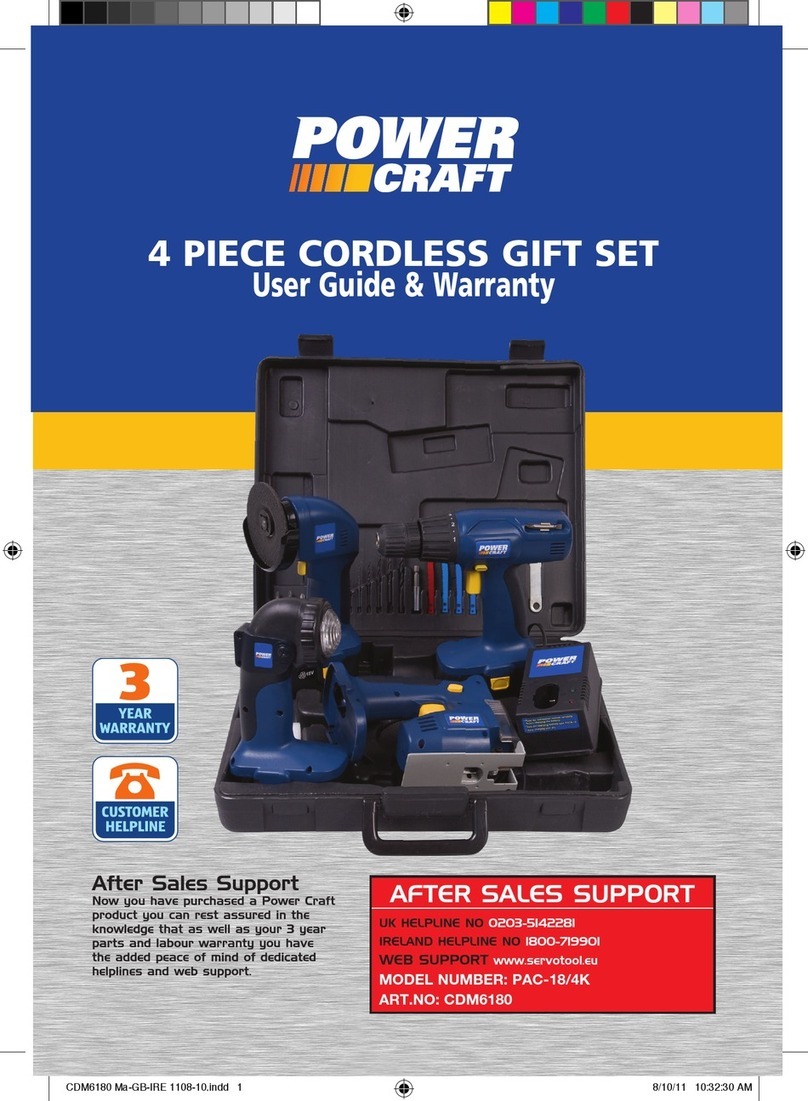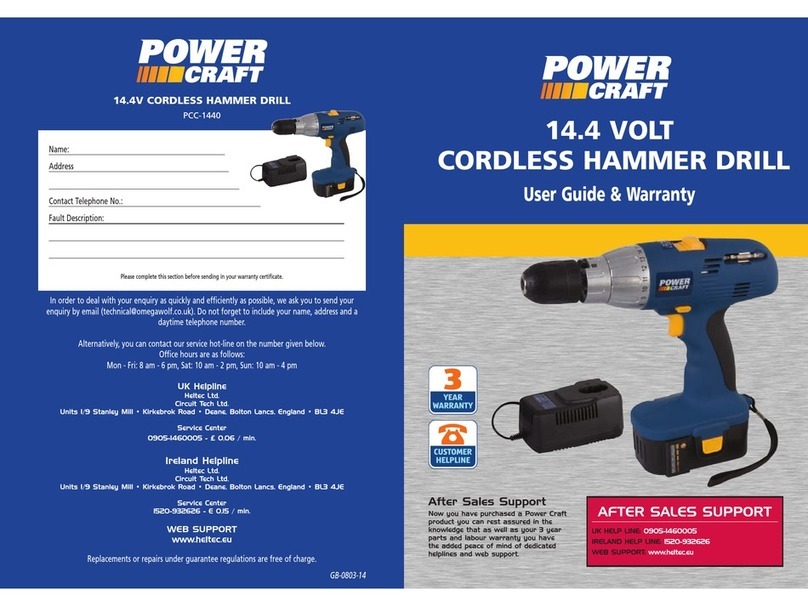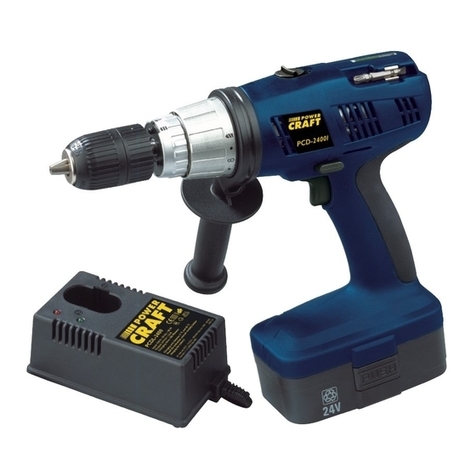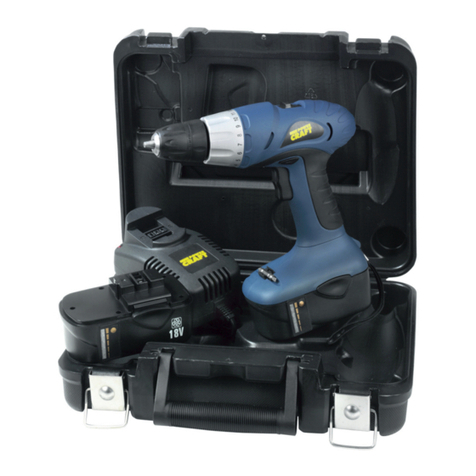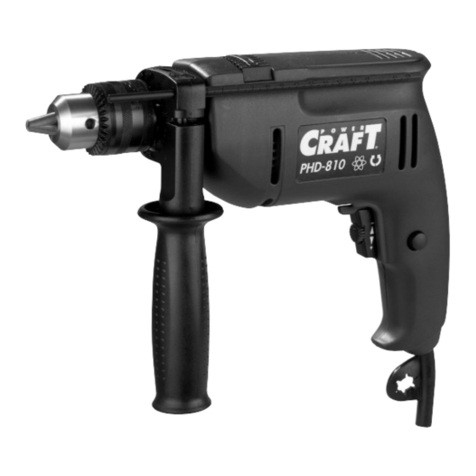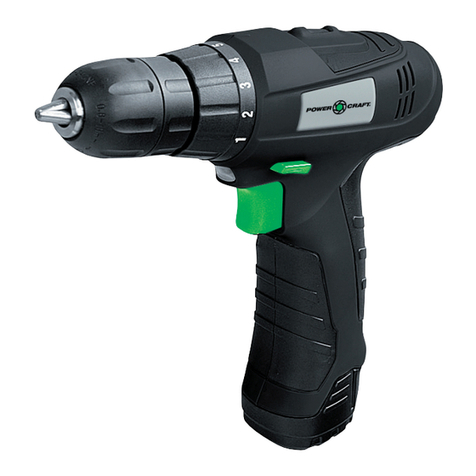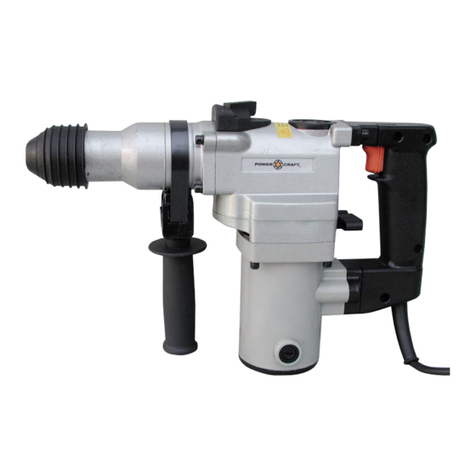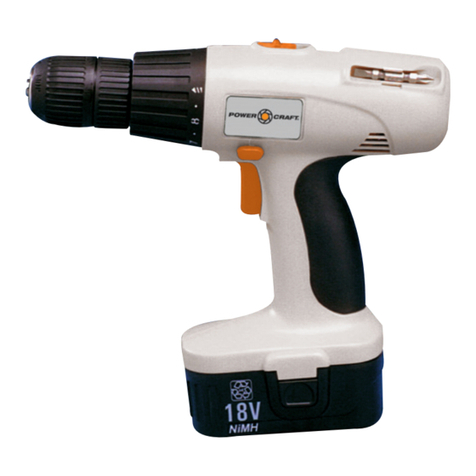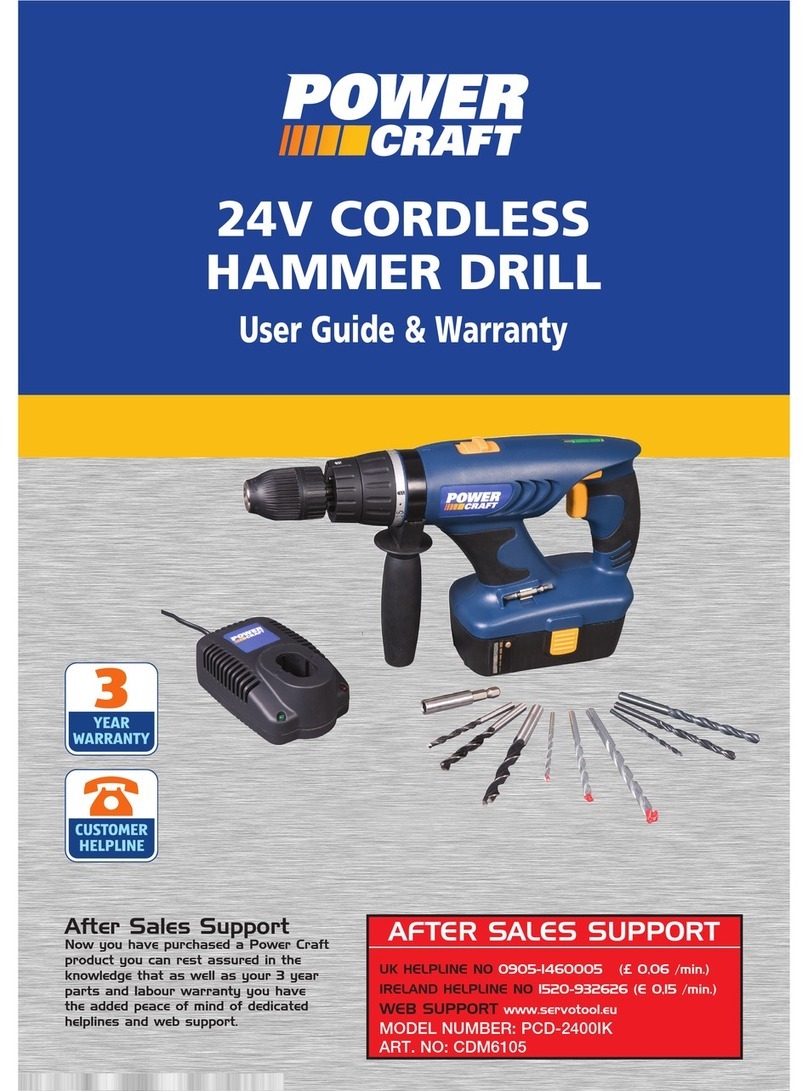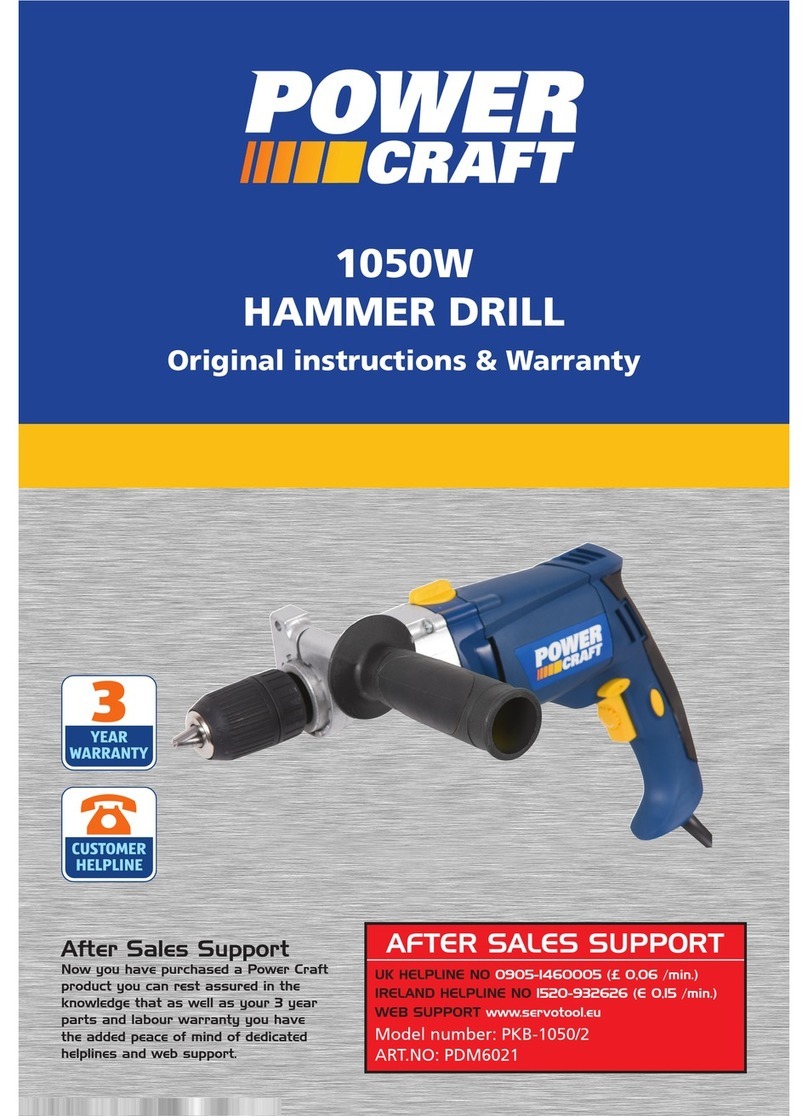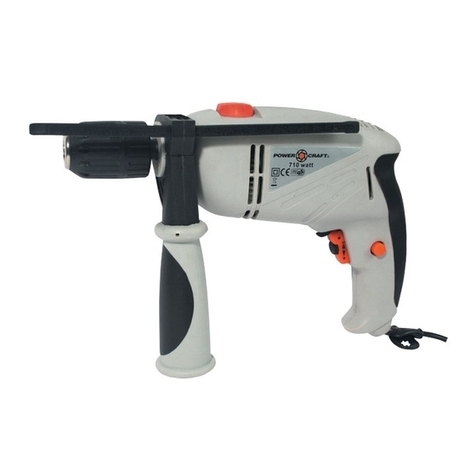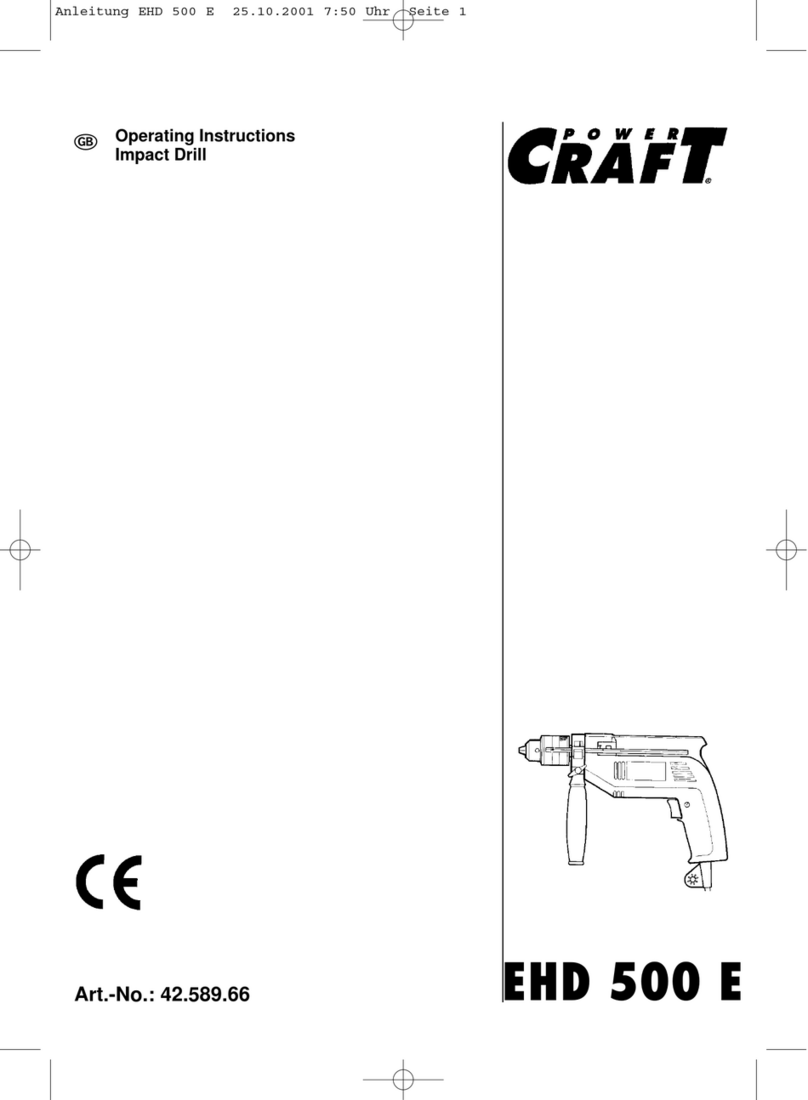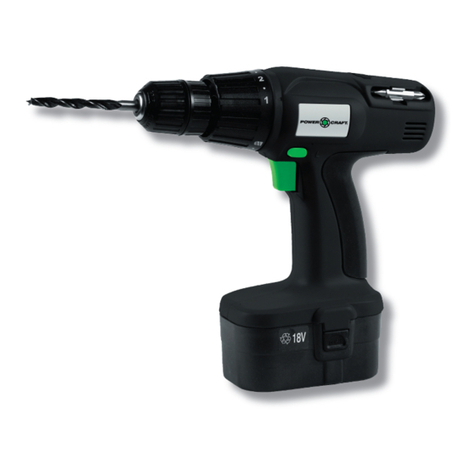MOUNTING ACCESSORIES
Prior to mounting an accessory always remove the
battery.
Inserting and removing the drill bits.
Fig. B
In addition to bits the machine can also hold screw bits
with a hexagonal shaft.
•Loosen the chuck (5) by holding one section and tur-
ning the other.
•Position the drill bit shaft in the take up of the chuck.
•Fasten the chuck until the drill bit is tight. Then tigh-
ten the chuck until hearing a click which indicateds
that the chuck is locked.
•Open the chuck again when you want to exchange
the drill bit.
Inserting and removing of the battery
Fig. C
•Make sure that the direction switch (1) is in middle
position to prevent the machine from switching on
unexpectedly.
•Place the accumulator (7) in the bottom of the
machine, as shown in the diagram, until it engages.
•Before removing the accumulator, depress the rele-
ase buttons (8) and then take the accumulator out
from the bottom of the machine
OPERATION
Fig. D
Always observe the safety instructions and applica-
ble regulations.
The drill must only be used with the forward / reverse switch
fully enclosed
Firmly hold the machine and push the bit with even pres-
sure into the workpiece. Do not force the machine.
Use only bits that do not yet show any signs of wear.
Worn bits have a negative effect on the efficiency of the
machine.
Torque adjustment.
The machine has different torque settings by means of
which the force for fastening and loosening screws can
be determined.
•Put the torque setting ring (4) at the required torque.
•Preferably select the lowest possible setting to move
the screw. Select a higher torque setting when the
motor is slipping.
Screwing screws in and out.
•Set the direction switch (1) on position 'R' for putting
in screws.
•Set the direction switch on position 'L' for removing
screws.
Drilling
•Turn the torque setting ring (4) to drilling position.
Be sure that the direction switch (1) always in posi-
tion 'R' during drilling.
Impact drilling.
Select a suitable drill bit for the practice use.
-For drilling in soft material like wood or plastic rotate
the impact sleeve (5) in clockwise until the indicator
points at the mark ‘DRILL BIT’ In this case use a metal
drill bit.
-For drilling in hard material like stone or concrete,
rotate the impact sleeve (5) in anti-clockwise until
the indicator points at the mark ‘HAMMER’. In this
case use a drill bit with carbide tip.
Regular check the chuck for possible damage.
Possible use a coolant. In case of drilling in walls,
watch out for drilling in electric wires of water pipes. Get
advice according to the use from your dealer.
Switching on and off.
Fig. E
•Press the on/off switch (2) in. You regulate the speed
of the machine by the degree to which you keep the
switch pressed in.
•Releasing the on/off switch (2) causes the drill to stop
immediately
•Slide the direction switch (1) to the middle to lock the
machine in switched off mode.
Do not put the machine away until the machine has com-
pletely stopped running. Do not store the machine on a
dusty surface. Dust particles can get into the mechanism.
Only operate the drill with the forward / reverse
switch (2) fully engaged. Never attend to use the
drill with this switch in the neutral position.
Setting the speed
The machine has two drilling speeds.
•Set the speed switch (12) to 'Pos. 1' for slow drilling
or tightening / loosening screws.
•Set the speed switch to 'Pos. 2' for high-speed drilling.
Charging batteries
Fig. F
The enclosed battery charger has been exclusively
designed for charging batteries of the FCD-2400 I.
•Position the battery (7) in the battery charger (9) as
indicated in the illustration.
•Plug in the battery charger. The red “fast charging”
light (10) is then illuminated
•As soon as the green light (11) is illuminated, charging
has finished and the accumulator is ready for use
Only use the battery charger in a dry environment
at a temperature between 10 °C and 40 °C.
The battery on the drilling machine you have purchased
is not charged up. Before using it for the first time leave it
to charge for 1 - 2 hours in order for it to reach its full
capacity. The total capacity of the battery will be reached
after it has been charged 4 – 5 times.
If the cordless drill is not going to be used for a long
period of time, recharge the battery before storing.
From time to time recharge the battery for a short period of
time, to prevent it from running down. Store the battery sepa-
rately in the plastic case.
Powercraft 5
from receptacle. Keep cord from heat, oil and sharp
edges.
11.Secure work.
Use clamps or a vise to hold work. It’s safer than using
your hand and it frees both hands to operate tool.
12.Don’t overreach.
Keep proper footing and balance at all times.
13.Maintain tools with care.
Keep tools sharp and clean for better and safer per-
formance. Follow instructions for lubricating and
changing accessories. Inspect tool cords periodically
and, if damaged, have repaired by authorized service
facility. Inspect extension cords periodically and
replace if damaged. Keep handles dry, clean and free
from oil and grease.
14.Disconnect tools.
When not in use, before servicing, and when chan-
ging accessories such as blades, bits and cutters.
15.Remove adjusting keys and wrenches.
Form the habit of checking to see that keys and adjus-
ting wrenches are removed from tool before turning
it on.
16.Avoid unintentional starting.
Don’t carry plugged-in tools with finger on switch. Be
sure switch is off when plugging in.
17.Outdoor use extension cords.
When tool is used outdoors, use only extension
cords intended for use outdoors and so marked.
18.Stay alert.
Watch what you are doing. Use common sense. Do
not operate tool when you are tired.
19.Check damaged parts.
Before further use of the tool, a guard or other part
that is damaged should be carefully checked to deter-
mine that it will operate properly and perform its
intended function. Check for alignment of moving
parts, binding of moving parts, breakage of parts,
mounting, and any other conditions that may affect its
operation. A guard or other part that is damaged
should be properly repaired or replaced by an autho-
rized service center unless otherwise indicated
elsewhere in this instructions manual. Have defective
switches replaced by an authorized center. Do not
use tool if switch does not turn it on and off.
20.Warning.
The use of any other accessory or attachment other
than recommended in this operation instructions or
the catalog may present a risk of personal injury.
21.Have your tool repaired by an expert.
This electric appliance is in accordance with the rele-
vant safety rules repairing of electric apliances may be
carried out only by experts otherwise it may cause
considerable danger for the user.
22.Connect the dust extraction device.
Whenever there are facilities for fitting a dust extrac-
tion system, make sure it is connected and used.
SPECIAL SAFETY INSTRUCTIONS
IMPORTANT SAFETY ADVICE CONCER-
NING THE BATTERY PACK & BATTERY
CHARGER
If you should come into contact with any acid
from the Battery pack, wash the affected parts
with water immediately. If acid should come into
contact with the eyes, rinse them immediately
with water and seek medical advice as soon as
possible.
1. Before using both the battery pack and the battery
charger, make sure you have read and understood
the operating instructions and safety information.
2. Only use the battery pack with the battery charger
provided – using other chargers could be dangerous.
3. Keep the battery pack, tool and battery charger away
from damp and wet conditions.
4. Before using the battery charger, check all wires are
properly connected.
5. If any wires on the charger are damaged, do not use it
until these have been replaced.
6. When the charger is not in use it should not be plug-
ged in. When unplugging, do not pull the plug out by
the cable.
7. If the charger breaks down or suffers from other
technical problems, take it to a recognised dealership
to be checked before using it again. Any damaged
parts must be replaced.
8. Take care when handling the battery pack, do not
drop it or knock it against other things.
9. Never attempt to repair the battery charger or bat-
tery pack yourself; this can be extremely dangerous.
Repairs should always be carried out by a recognised
dealership.
10. Always unplug the charger before cleaning or car-
rying out any other maintenance on it.
11. Do not attempt to charge the battery pack in tempe-
ratures of below 10 degrees or above 40 degrees
centigrade.
12. The air vents on the battery charger must be kept
unblocked.
13. The battery pack must not be short-circuited.
When an apparatus short-circuits, the strength of
the electric current is increased. This can cause the
apparatus to over heat, catch fire or even explode, causing
damage and also endangering the operator.
To avoid this;
1. Firstly do not connect any wires to the terminals
of the battery pack;
2. Ensure that no metal objects (nails, coins, paper-
clips) are caught in the opening of the battery
pack;
3. Do not expose the battery pack to water or rain.
14. If the battery pack is broken or can no longer be re-
charged it must be properly disposed of.
15. Never throw the battery pack into water or a fire – it
may explode.
4Powercraft
